
|
acetic acid |
acetic acid is a lipid of Fatty Acyls (FA) class. Acetic acid is associated with abnormalities such as Vitamin B 12 Deficiency. The involved functions are known as Excretory function. The related lipids are Propionate. |
89633 |
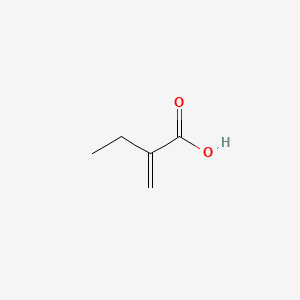
|
2-Ethylacrylic acid |
2-Ethylacrylic acid is a lipid of Fatty Acyls (FA) class. The involved functions are known as hemolysis. |
869 |

|
Arachidonic acid |
Arachidonic acid is a lipid of Fatty Acyls (FA) class. Arachidonic acid is associated with abnormalities such as Atherosclerosis, Ischemia, Hypertensive disease, Hypertension induced by pregnancy and Vascular ring of aorta. The involved functions are known as Platelet aggregation, Anabolism, Ion Transport, Signal Transduction Pathways and Signal. Arachidonic acid often locates in Extracellular, Body tissue, Protoplasm, Tissue membrane and soluble. The associated genes with Arachidonic acid are CYP2J2 gene, CYP2E1 gene, Recombinant Proteins, POR gene and P4HTM gene. The related lipids are Fatty Acids, Glycerophospholipids, Steroids, octadecadienoic acid and 9-hydroxy-10,12-octadecadienoic acid. The related experimental models are Mouse Model and Knock-out. |
22864 |

|
DHA |
Dha is a lipid of Fatty Acyls (FA) class. Dha is associated with abnormalities such as Atherosclerosis, Consumption-archaic term for TB, Chronic disease, Cardiovascular Diseases and Diabetes Mellitus, Non-Insulin-Dependent. The involved functions are known as Inflammation, Oxidation, fatty acid oxidation, Fatty Acid Metabolism and Lipid Metabolism. Dha often locates in Hepatic, Protoplasm, Mucous Membrane, Epithelium and outer membrane. The associated genes with DHA are IMPACT gene, FATE1 gene, GAPDH gene, THOC4 gene and SLC33A1 gene. The related lipids are stearidonic acid, Fatty Acids, Total cholesterol, Lipopolysaccharides and Dietary Fatty Acid. The related experimental models are Mouse Model, Transgenic Model, Animal Disease Models and Arthritis, Experimental. |
11054 |
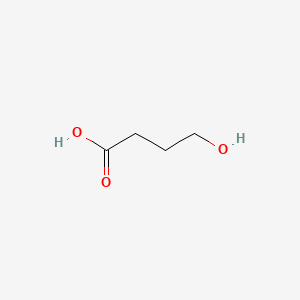
|
4-hydroxy-butyric acid |
4-hydroxy-butyric acid is a lipid of Fatty Acyls (FA) class. |
3927 |

|
Pyruvic acid |
Pyruvic acid is a lipid of Fatty Acyls (FA) class. |
27047 |

|
6-aminohexanoic acid |
6-aminohexanoic acid is a lipid of Fatty Acyls (FA) class. 6-aminohexanoic acid is associated with abnormalities such as Blood Clot, Myocardial Infarction, Cerebrovascular accident, Renal impairment and Scoliosis, unspecified. The involved functions are known as Fibrinolysis, Agent, Hemorrhage, plasminogen activation and inhibitors. 6-aminohexanoic acid often locates in Chest, Blood, Body tissue, peritoneal and Plasma membrane. The associated genes with 6-aminohexanoic acid are P4HTM gene, BSND gene, MTPN gene, NDUFS4 gene and Homologous Gene. The related lipids are Phosphatidylserines and Butyric Acid. |
3685 |

|
4-aminobutyric acid |
4-aminobutyric acid is a lipid of Fatty Acyls (FA) class. 4-aminobutyric acid is associated with abnormalities such as Epilepsy and Premenstrual syndrome. The involved functions are known as Binding (Molecular Function), neuron survival, Process, Uptake and physiological aspects. 4-aminobutyric acid often locates in Microglial, Neurofilament, Neuraxis, Brain region and Neurites. The associated genes with 4-aminobutyric acid are arginine methyl ester, SLC33A1 gene, NKS1 gene, P4HTM gene and ITSN2 gene. The related lipids are pregnenolone sulfate, pregnane-20-one, Pregnanes, Steroids and endogenous steroids. |
19702 |
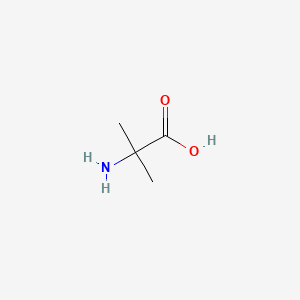
|
2-amino-isobutyric acid |
2-amino-isobutyric acid is a lipid of Fatty Acyls (FA) class. |
1792 |

|
2,5-diaminopentanoic acid |
2,5-diaminopentanoic acid is a lipid of Fatty Acyls (FA) class. The involved functions are known as Vasodilation, Intestinal Absorption and Pinocytosis. 2,5-diaminopentanoic acid often locates in Mitochondria, Microfilaments, NADH dehydrogenase complex and respiratory chain complex III location sensu Eukarya. The associated genes with 2,5-diaminopentanoic acid are GAPDH gene and iberiotoxin. |
8868 |
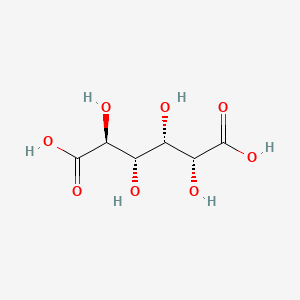
|
Glucaric acid |
Glucaric acid is a lipid of Fatty Acyls (FA) class. Glucaric acid is associated with abnormalities such as Consumption-archaic term for TB and furuncle. The involved functions are known as Oxidation, Mutation, Process, Cell Growth and Anabolism. Glucaric acid often locates in BL21, Clone and host. The associated genes with Glucaric acid are MIOX gene, ISYNA1 gene, Genome and Candidate Disease Gene. The related experimental models are Knock-out. |
1814 |
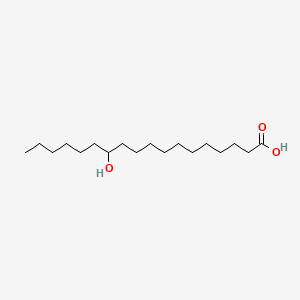
|
12-hydroxystearic acid |
12-hydroxystearic acid is a lipid of Fatty Acyls (FA) class. |
56 |

|
Prostaglandin E2 |
Prostaglandin E2 is a lipid of Fatty Acyls (FA) class. Prostaglandin e2 is associated with abnormalities such as Renal glomerular disease, Arthritis, Degenerative polyarthritis, Pancreatitis and Rheumatoid Arthritis. The involved functions are known as enzyme pathway, Atherogenesis, Anabolism, inhibitors and Oxidants. Prostaglandin e2 often locates in Tissue membrane, Blood, Extracellular, Membrane and Protoplasm. The associated genes with Prostaglandin E2 are PTGS2 gene, TP53 gene, TNFRSF5 gene, FASTK Gene and TNF gene. The related lipids are Lipopolysaccharides, Steroids, monooxyethylene trimethylolpropane tristearate, Fatty Acids, Unsaturated and Promega. The related experimental models are Arthritis, Adjuvant-Induced, Xenograft Model, Experimental Autoimmune Encephalomyelitis, Cancer Model and Knock-out. |
49278 |

|
PGD2 |
Pgd2 is a lipid of Fatty Acyls (FA) class. Pgd2 is associated with abnormalities such as Inflammatory disorder, Pleurisy, Rhinitis, Dehydration and Pneumonia. The involved functions are known as antagonists, fat cell differentiation, Phosphorylation, Process and Gene Expression. Pgd2 often locates in Cell surface, Body tissue, Extracellular, Bone Marrow and Membrane. The associated genes with PGD2 are oxytocin, 1-desamino-(O-Et-Tyr)(2)-, P4HTM gene, PTGS2 gene, PTGDS gene and IL3 gene. The related lipids are 15-deoxyprostaglandin J2, Nonesterified Fatty Acids, Lipopolysaccharides, Steroids and Liposomes. The related experimental models are Knock-out and Rodent Model. |
6464 |
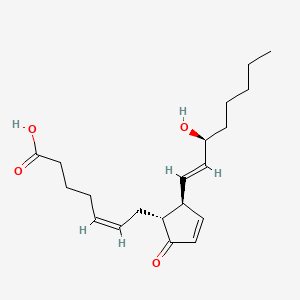
|
PGA2 |
Pga2 is a lipid of Fatty Acyls (FA) class. Pga2 is associated with abnormalities such as Pneumonia and Endothelial dysfunction. The involved functions are known as Regulation, Transcription, Genetic, Signal Transduction, kinase activity and Phosphorylation. Pga2 often locates in Cytoplasm, Protoplasm, Endothelium, Cytoskeleton and actin cytoskeleton. The associated genes with PGA2 are CDK2 gene, CCL2 gene, RHOA gene, thrombin receptor peptide SFLLRNP and ADRBK1 gene. The related lipids are Lipopolysaccharides. The related experimental models are Knock-out. |
236 |

|
11beta-PGF2 |
11beta-pgf2 is a lipid of Fatty Acyls (FA) class. |
15009 |
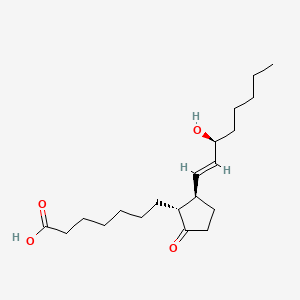
|
11-deoxy-PGE1 |
11-deoxy-pge1 is a lipid of Fatty Acyls (FA) class. |
86 |
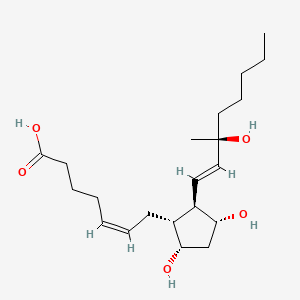
|
Carboprost |
Carboprost is a lipid of Fatty Acyls (FA) class. |
289 |
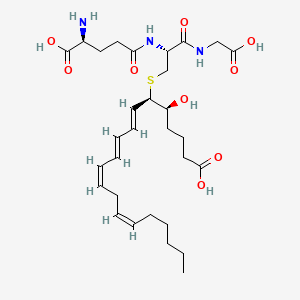
|
LTC4 |
Ltc4 is a lipid of Fatty Acyls (FA) class. Ltc4 is associated with abnormalities such as Asthma, Eosinophilia, Pulmonary Eosinophilia, Pneumonia and Cardiovascular Diseases. The involved functions are known as Signal, Gene Expression, Stimulus, Signal Transduction and Metabolic Inhibition. Ltc4 often locates in Plasma membrane, Cytoplasm, Back, Cytoplasmic and Tissue membrane. The associated genes with LTC4 are STIM1 gene, ABCC2 gene, CD9 gene, Mutant Proteins and Amino Acids, Aromatic. The related lipids are glycolithocholate. |
2252 |

|
Thromboxane b2 |
Thromboxane b2 is a lipid of Fatty Acyls (FA) class. Thromboxane b2 is associated with abnormalities such as endothelial dysfunction, Diabetes Mellitus, Non-Insulin-Dependent, Diabetes Mellitus, Ischemia and Thrombocytosis. The involved functions are known as Platelet Activation, Excretory function, Anabolism, Inflammation and mRNA Expression. Thromboxane b2 often locates in Endothelium, Hepatic and Microsomes, Liver. The associated genes with Thromboxane b2 are PTGS2 gene, prothrombin fragment 2 and CCL14 wt Allele. |
10175 |
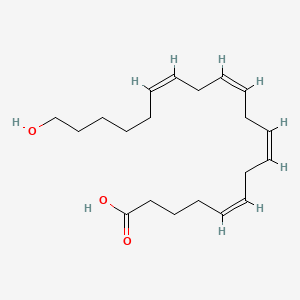
|
20-HETE |
20-hete is a lipid of Fatty Acyls (FA) class. 20-hete is associated with abnormalities such as Cyst, Kidney Diseases, Kidney Failure, Chronic, Cystic Kidney Diseases and Simple renal cyst. The involved functions are known as Phosphorylation, inhibitors, Hypertrophy, Epithelial Cell Proliferation and Anabolism. 20-hete often locates in Mouse Kidney, Microsomes, Tissue membrane, Body tissue and Cytoplasmic matrix. The associated genes with 20-HETE are CYP4F3 gene, PKHD1 gene, Transgenes, P4HTM gene and CYP2E1 gene. The related lipids are Promega, enterodiol, Fatty Acids, hexanoic acid and U 73343. The related experimental models are Mouse Model, Knock-out, Streptozotocin Diabetes, Transgenic Model and Rodent Model. |
1257 |
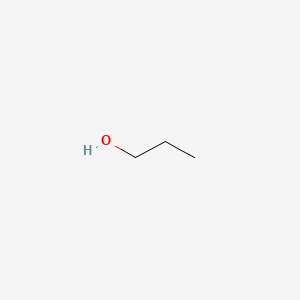
|
1-propanol |
1-propanol is a lipid of Fatty Acyls (FA) class. |
6697 |
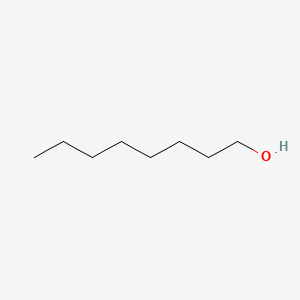
|
n-octanol |
N-octanol is a lipid of Fatty Acyls (FA) class. N-octanol is associated with abnormalities such as Wiskott-Aldrich Syndrome. The involved functions are known as Mutation and Detergents. N-octanol often locates in Tissue membrane. The related lipids are Octanols and 1-Octanol. |
3305 |

|
4-hydroxynonenal |
4-hydroxynonenal is a lipid of Fatty Acyls (FA) class. 4-hydroxynonenal is associated with abnormalities such as Chronic disease, Obesity, Diabetes, Acquired Immunodeficiency Syndrome and Lung diseases. The involved functions are known as protein expression, Glycolysis, mRNA Expression, Regulation and Mitochondrion in division. 4-hydroxynonenal often locates in Muscle, Mitochondria, Adipose tissue, Head and Mouse Muscle. The associated genes with 4-hydroxynonenal are STAT3 gene, SIRT1 gene, PGC gene, IL6 gene and cytochrome c''. The related lipids are Lipopolysaccharides, Lipid Peroxides, Promega, Membrane Lipids and oxidized lipid. The related experimental models are Mouse Model, Knock-out, Transgenic Model, Disease model and Rodent Model. |
5685 |
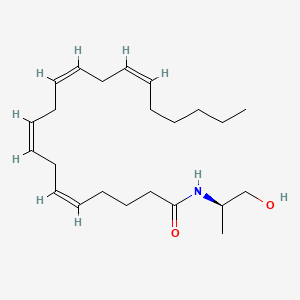
|
N-(1R-methyl-2-hydroxy-ethyl) arachidonoyl amine |
N-(1r-methyl-2-hydroxy-ethyl) arachidonoyl amine is a lipid of Fatty Acyls (FA) class. |
457 |

|
Anandamide |
Anandamide is a lipid of Fatty Acyls (FA) class. Anandamide is associated with abnormalities such as Dehydration. The involved functions are known as Process, Phenomenon, Phosphorylation, Catabolic Process and Gene Expression. Anandamide often locates in Nuchal region, Microglial and Hepatic. The associated genes with Anandamide are SGPL1 gene, SPTLC1 gene, RPSA gene, KDSR gene and SMPD1 gene. The related lipids are Sphingolipids, Lipopolysaccharides, Lysophospholipids, LYSO-PC and lysophosphatidylethanolamine. |
4747 |
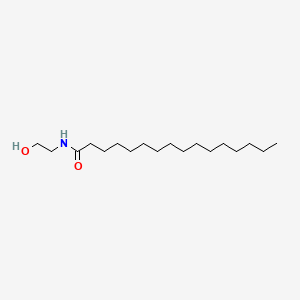
|
Palmitoyl-EA |
Palmitoyl-ea is a lipid of Fatty Acyls (FA) class. The involved functions are known as Cytokinesis of the fertilized ovum and phosphatase activity. The related lipids are stearic acid. |
1001 |
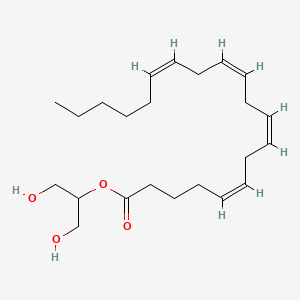
|
2-arachidonoylglycerol |
2-arachidonoylglycerol is a lipid of Glycerolipids (GL) class. 2-arachidonoylglycerol is associated with abnormalities such as Atherosclerosis, Heart Diseases, Inflammatory disorder, Colitis and Peripheral Neuropathy. The involved functions are known as Immunoreactivity, inhibitors, Stimulus, Esthesia and Signal Transduction. 2-arachidonoylglycerol often locates in Back, Presynaptic Terminals, Brain region, Blood and Body tissue. The associated genes with 2-arachidonoylglycerol are ADRBK1 gene, Homologous Gene, MGLL gene, PLA2G4A gene and peptide V. The related lipids are oleoylethanolamide, Lipopolysaccharides, Promega, stearic acid and 1-stearoyl-2-arachidonoylglycerol. The related experimental models are Knock-out. |
1892 |
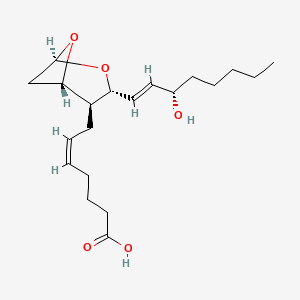
|
Thromboxane a2 |
Thromboxane a2 is a lipid of Fatty Acyls (FA) class. Thromboxane a2 is associated with abnormalities such as Asthma, Cardiovascular Diseases, Pulmonary Eosinophilia, ASPIRIN SENSITIVITY and Pneumonia. The involved functions are known as Signal Transduction, paracrine, Binding (Molecular Function), Platelet Activation and Inflammation. Thromboxane a2 often locates in Cell surface, Body tissue, Cell membrane, Blood and Extracellular. The associated genes with Thromboxane a2 are PTPRC gene, ESAM gene and PPBP gene. |
4534 |

|
Platelet activating factor |
Platelet activating factor is a lipid of Glycerophospholipids (GP) class. Platelet activating factor is associated with abnormalities such as Atherosclerosis, Acute cholecystitis without calculus, Cholecystitis, Colitis and Cholecystitis, Acute. The involved functions are known as Cell Survival, Metabolic Inhibition, lipid oxidation, Apoptosis and Oxidation. Platelet activating factor often locates in soluble, Cellular Membrane, Smooth muscle (tissue), Intima and Tissue specimen. The associated genes with Platelet activating factor are apolipoprotein A-I Milano, Homologous Gene, TSPO gene, HBEGF gene and SLC33A1 gene. The related lipids are Hydroxycholesterols, Liposomes, 25-hydroxycholesterol, Lysophosphatidylcholines and Lipopolysaccharides. The related experimental models are Knock-out, Mouse Model and Transgenic Model. |
7383 |
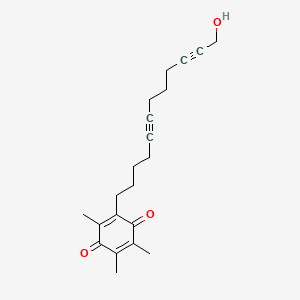
|
Aa-861 |
|
57 |

|
1-Oleoyl Lysophosphatidic Acid |
1-Oleoyl Lysophosphatidic Acid is a lipid of Glycerophospholipids (GP) class. 1-oleoyl lysophosphatidic acid is associated with abnormalities such as Myocardial Infarction, early pregnancy, Scleroderma, Blind Vision and Hyperlipidemia. The involved functions are known as Agent, Blood coagulation, Selection, Genetic, Analyte and Biological Processes. 1-oleoyl lysophosphatidic acid often locates in Tissue specimen, Body tissue, Blood, Membrane and Skin. The associated genes with 1-Oleoyl Lysophosphatidic Acid are Mucin-16, Peptides, SMAD4 gene, RND1 gene and Polypeptides. The related lipids are lysophosphatidic acid, A(2)C, Lysophospholipids, Fatty Acids and sphingosine 1-phosphate. The related experimental models are Mouse Model, Knock-out, Cancer Model, Xenograft Model and Arthritis, Adjuvant-Induced. |
3463 |

|
tacrolimus |
Tacrolimus is a lipid of Polyketides (PK) class. Tacrolimus is associated with abnormalities such as Renal glomerular disease. The involved functions are known as inhibitors, Fungicidal activity, Metabolic Inhibition, Excretory function and Dephosphorylation. Tacrolimus often locates in Hepatic, Mitochondrial matrix and Inner mitochondrial membrane. The associated genes with Tacrolimus are RHOA gene and BGN gene. |
12730 |

|
erythromycin |
erythromycin is a lipid of Polyketides (PK) class. Erythromycin is associated with abnormalities such as Systemic Inflammatory Response Syndrome, Pneumonia, Infection, Pneumococcal Infections and Exanthema. The involved functions are known as Pharmacodynamics, Sterility, Agent, Drug Kinetics and Adjudication. Erythromycin often locates in Blood, peritoneal, Extracellular, Ribosomes and apicoplast. The associated genes with erythromycin are P4HTM gene, SLC33A1 gene, FAM3B gene, Operon and Homologous Gene. The related lipids are Hydroxytestosterones, Steroids, Propionate, Mycolic Acids and campesterol. The related experimental models are Mouse Model and Knock-out. |
19871 |

|
Azithramycine |
Azithramycine is a lipid of Polyketides (PK) class. Azithramycine is associated with abnormalities such as Respiratory Tract Infections, Pneumonia, Lower respiratory tract infection, Infection and Nonspecific urethritis. The involved functions are known as Lysis, Selection, Genetic, Mutation, Relapse and Adaptation. Azithramycine often locates in Blood, Respiratory System, Genitourinary system, Back and Chest. The associated genes with Azithramycine are Genes, rRNA, Genome, RPL22 gene, OPRM1 gene and tryptic soy broth. The related lipids are Liposomes, Phosphatidylserines, Promega, Lipopolysaccharides and Steroids. The related experimental models are Mouse Model, Knock-out and Tissue Model. |
7835 |

|
minocycline |
minocycline is a lipid of Polyketides (PK) class. Minocycline is associated with abnormalities such as Infection, Soft Tissue Infections, Septicemia, Chronic hyponatremia and Lesion of brain. The involved functions are known as Pharmacodynamics, Gene Expression, Transcriptional Activation, Regulation and Process. Minocycline often locates in Ribosomes, 50S ribosomal subunit, Blood, Skin and Immune system. The associated genes with minocycline are THEMIS gene, KCNK2 gene, RBFOX3 gene, PIWIL2 gene and P4HTM gene. The related lipids are Lipopolysaccharides, Promega, Steroids, Liposomes and Octanols. The related experimental models are Mouse Model, Experimental Autoimmune Encephalomyelitis, Genetically Engineered Mouse, Disease model and spinal model. |
9780 |

|
baicalein |
baicalein is a lipid of Polyketides (PK) class. Baicalein is associated with abnormalities such as Neurodegenerative Disorders, Fibrillation, Hypertensive disease, Aortic coarctation and Coronary Occlusion. The involved functions are known as Anabolism, Polymerization, Process, inhibitors and Pathogenesis. Baicalein often locates in Membrane, Lipid Bilayers, soluble, Cell-Free System and Protoplasm. The associated genes with baicalein are P4HTM gene, BIRC5 gene, TSPO gene, SHOC2 gene and XIAP gene. The related lipids are Fatty Acids, Nonesterified Fatty Acids, iodoresiniferatoxin, Lipopolysaccharides and 17-octadecynoic acid. The related experimental models are Knock-out, Mouse Model and Parkinsonism, Experimental. |
1997 |
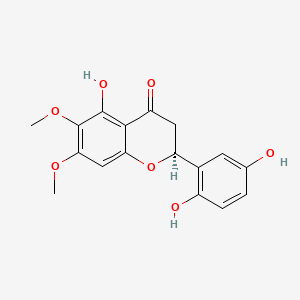
|
Dioclein |
Dioclein is a lipid of Polyketides (PK) class. |
28 |

|
doxorubicin |
Adriamycin is a lipid of Polyketides (PK) class. Adriamycin is associated with abnormalities such as Cardiomyopathies. The involved functions are known as Transcription, Genetic, Process, Drug effect disorder, Diastasis and Oxidation-Reduction. Adriamycin often locates in Muscle, Myocardium and Entire gastrointestinal tract. |
54913 |

|
forskolin |
Forskolin is a lipid of Prenol Lipids (PR) class. Forskolin is associated with abnormalities such as Cholestasis, Vocal cord dysfunction familial, Hypothyroidism, Renal tubular disorder and Disintegration (morphologic abnormality). The involved functions are known as Cell Proliferation, Anabolism, mRNA Expression, Agent and Signal. Forskolin often locates in Extracellular, Body tissue, Skin, Tissue membrane and Membrane. The associated genes with forskolin are P4HTM gene, SLC33A1 gene, NR1I2 gene, Genes, Reporter and CYP3A gene. The related lipids are Steroids, steroid sulfate, Fatty Acids, LYSO-PC and Lipopolysaccharides. |
24755 |

|
cholesterol |
cholesterol is a lipid of Sterol Lipids (ST) class. Cholesterol is associated with abnormalities such as Trypanosomiasis, Chagas Disease, Cleft Palate, Chondrodysplasia punctata 2, X-linked dominant and Child syndrome. The involved functions are known as Blood Circulation, Sterol Biosynthesis Pathway, Receptor Mediated Endocytosis, Methylation and Signal. Cholesterol often locates in Animal tissue, Blood, Membrane, Plasma membrane and peroxisome. The associated genes with cholesterol are MBD2 gene, SIM, SLC33A1 gene, Genome and NSDHL gene. The related lipids are Sterols, zymosterol, fecosterol, Total cholesterol and 7-dehydrocholesterol. The related experimental models are Mouse Model, Knock-out, Genetically Engineered Mouse and Disease model. |
98461 |








































